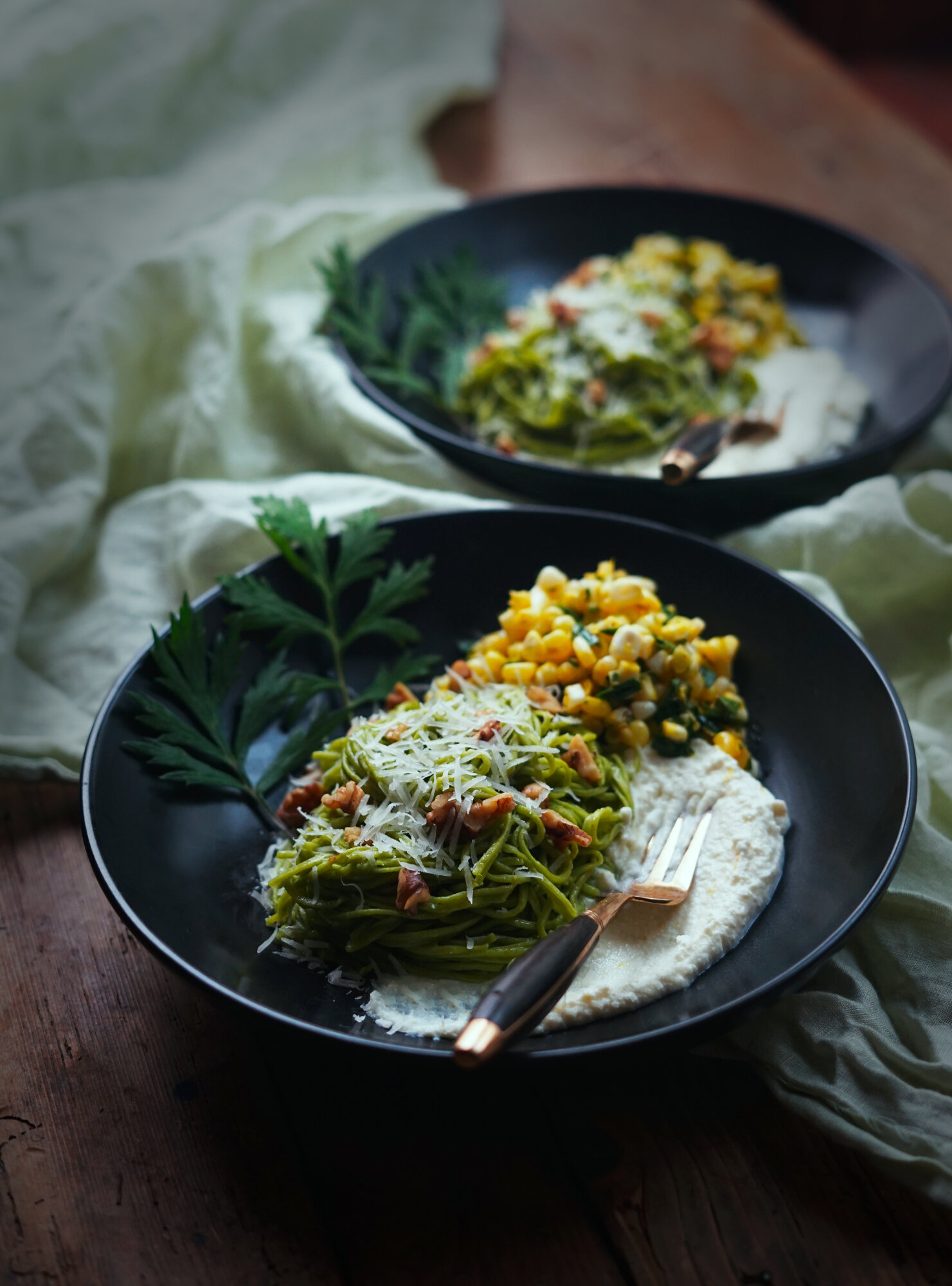Rebellion Pasta with Mugwort and Summer Relish
New to foraging? Learn more about ethical and safe foraging (plus how to get started) here!
I have an extraordinary vintage book on my shelf that never fails to make me laugh until I cry, with a secondary reaction of absolutely craving pasta. It’s called The Futurist Cookbook and it was compiled and published in 1989, containing materials dating from the turn of the 20th century, mostly collected from the estate of one Fillippo Tommaso Marinetti, a passionate and intense Italian Futurist with some VERY strong opinions, mostly about pasta. (Spoiler alert: he didn’t like it very much.) In fact, he hated pasta SO MUCH that about half of his Manifesto of Futurist Cooking was emphatically dedicated to abolishing pasta:
“Any pastasciuttist who honestly examines his conscience at the moment he ingurgitates his biquotidian pyramid of pasta will find within the gloomy satisfaction of stopping up a black hole.” - F.T. Marinetti
Like I said, some big feelings. At first read, this book seems like some kind of parody or satire- could pasta really provoke such an intense reaction warranting many articles on the subject? The introduction to the book (added when it was published in 1989) explores this question, and no conclusion is made. Some believe The Futurist Cookbook is one big joke; others believe that F.T. Marinetti and his cohorts took themselves VERY seriously, and others see it as an experimental art project. In any case, it makes for some particularly entertaining reading and I’ll admit that it has left me in fits of laughter on more than one occasion.
A little context: Italian Futurism was born from the Industrial Revolution, a focus on charging into a future based on speed, efficiency, and creative expression rooted in these new ideals. Futurism was about masculine energy, sleek metals, the greys and blacks of industry, and an intense desire to move away from tradition and into innovation. This art movement was more than the abstracted paintings that evolved into cubism; it was about a new way of living, a new hope for the future. The Futurists took this idea and ran with it, developing recipes that are as bizarre as they are unappetizing (one of my favorites, “Steel Chicken,” involves cooking a chicken with ball bearings, sewing on several cockscombs for decoration, and then serving it with whipped cream.) I don’t know about you, but I’ll take a bowl of pasta over steel-infused chicken any day of the week.
This book is inspiring in that it really has reimagined the sensory experience of dining. It is horrifying in many of the proposed recipes. It is hilarious in its emphatic stance on pasta. Let’s visit a few more voices on the subject:
An excerpt from an article titled “An Open Letter to F.T. Marinetti” by Marco Ramperti:
“We should also liberate ourselves from pasta, which is also a form of slavery. It puffs out our cheeks like grotesque masks on a fountain, it stuffs our gullets as if we were Christmas turkeys, it ties up our insides with its flabby strings; it nails us to the chair, gorged and stupefied, apoplectic and gasping, with that sensation of uselessness which, depending on the individual, brings pleasure or shame, but in any case must be abhorred by anyone boasting a Futurist spirit or anyone young and alert.”
Oh goodness. Who knew that pasta was such a demanding domme in the world of gustation? This next excerpt is probably my favorite, though. The language usage alone has me rolling with laughter by the end… of all the things to get so offended by, Silvano chose pasta. I hope you get a giggle from it too.
A couple of excerpts from a long article titled “A Contribution to a Futurist Culinary Art” by Libero Glauco Silvano:
“For Heaven’s sake, wasn’t it time to do something about that barbaric food which had only survived by scrounging off our ultramodern civilization: I’m speaking of macaroni in a sauce, with tomatoes or however you like it. This dish, surely more bestial than any other, looks to us like a female chimpanzee in a sentimental ladies’ drawing room: and it’s only through a mistaken respect for tradition that people have continued to tolerate its plebian stench.... I can just see them, those moustachioed Ostrogoths, setting themselves to gouge out great holes in the grass with their heavy daggers and then squatting round them, wiping their mouths on the ends of their moustaches in seraphic anticipation. Then their worthy consorts, worn and filthy, come and empty into these improvised bowls a slimy heap of worms called ‘macaroni’ and their hairy arms plunge into the fuming hole up to the elbow and their mouths open wide -- gobble gobble -- and tears run down their grimy cheeks in an excess of bliss.”
Oh. My. Historical racism aside, that is a lot of passion to funnel into the subject of something so mundane as pasta, don’t you think? Even the French had something to say on the subject:
From the French journalist Audisio in support of Futurist cooking: ‘
“Yes, pasta really is a dictatorship of the stomach, yes, it brings with it a torpor that borders on bliss, and it is indeed the succulent poison that ruins the liver for the greater joy of the stomach. We are not among those who despise it, we even love it… but we distrust it especially if prepared the Roman way, which is to say, undercooked. Because to digest it is an insidious, slow process of rumination, inviting feeble imaginings, empty dreams, sceptical renunciation, in the unctuous conciliatory rhythm of the sloth.”
Yes, they really went there.
I think my favorite part about revisiting this book is considering the way value systems shape every part of our cultures, right down to the food on our plates. Spurred on by the excitement of the Industrial Revolution, these Italian Futurists valued innovation, industry, speed, and masculine energy. Something as traditional, soporific, and comforting as pasta was, therefore, seen as an opposing force for everything they stood for.
Now, our societal views of industry have changed greatly. We’ve witnessed the evils of Big Industry - the poor working conditions, the pollution, the pressure to be productive above all else. Industrialized production has lost its novelty, and more and more people are showing interest in a return to the natural, the handmade, the slow, and the comforting. It’s clear that in this world, a bowl of lovingly-handmade pasta carries vastly different connotations than it did to the Futurists. And as for “feeble imaginings, empty dreams, and sceptical renunciation,” I beg your pardon, sir, but this pasta invites no such things. Quite the opposite, in fact!
Firstly, I’d like to direct your attention to the dynamic summery combination of raw sweet corn, toasted walnuts, spicy yellow pepper sauce, freshly foraged mint, and plenty of cheese.
Second, we have mugwort in the homemade pasta, a bitter herb in the sage family that is known for its effect of producing vivid, often lucid, dreams. The bitterness aids digestion and helps to break down starches and fats, while the flavor is uplifting and herbal. Empty dreams indeed.
As for “skeptical renunciation,” well, you’ve got me there. I renounce the abolition of pasta! I am passionately skeptical of the vilification of delicious noodles! If you’d like to join this passionate cause, the recipe of rebellion is below!
Rebellion Pasta: Mugwort with Late Summer Relish and Cheese
Mugwort Pasta:
1 c. fresh mugwort
2 c. fresh basil
3 egg yolks
1 ¾ - 2 c. pasta flour
Salt to cook
Instructions
Bring a medium pot of water to boil. Meanwhile, prepare an ice bath. Add the mugwort and basil to the boiling water and blanch for 2 minutes, then drain and plunge into the ice water. Strain, and add to a food processor along with ¼ c. water. Blend until very smooth.
In a small bowl, whisk together the herb puree and the egg yolks.
In a larger bowl, add the pasta flour and make a well in the center. Add the egg yolk mixture and start mixing with a fork until the dough comes together. The dough should form a ball and be soft but not sticky; add more flour as needed to reach the desired consistency.
Knead the dough on a lightly floured surface until it is elastic and springs back when you poke it. Wrap in plastic wrap and let sit at room temperature for half an hour. This is a good time to make the relish, below.
Divide the dough into quarters. Keeping the others covered, reshape one quarter into a rectangle and dust with flour. Roll it through the widest setting on the pasta machine. Fold it in half and then in half the other way and run it through again. Repeat this as needed until the dough is smooth.
Keeping the dough well dusted with flour, keep running it through smaller and settings until it is the desired thickness.
Run it through the spaghetti setting of the pasta maker and set aside, covered. Repeat the process with the rest of the pasta. Meanwhile, bring a pot of heavily salted water to a boil.
Add the noodles and cook until the noodles float to the surface, about 3 minutes. Strain, briefly rinse, and toss with a little olive oil.
Pasta Toppings:
2 c. fresh ricotta
1 Tbs. lemon juice
1 tsp. Lemon zest
2 ears raw corn
3 Tbs. chopped garlic chives
Small handful fresh mint
2 Tbs. lemon juice
Salt and freshly-ground pepper, to taste
¼ c. olive oil
2 Tbs. Aji Amarillo sauce (or a couple of chopped jalapeños)
1 c. grated pecorino romano
1 c. toasted walnuts, roughly chopped
Directions:
To make the lemon ricotta, just mix the fresh ricotta with the lemon juice and lemon zest and set aside.
To make the relish, cut the kernels off the corn cobs and add them to a bowl. Slice the green onions and add them. Roughly chop the wild mint and add it. Toss together.
In a small bowl, mix together the lemon juice, olive oil, and aji amarillo sauce, then toss it with the rest of the ingredients. Season with salt and pepper.
Spread some lemon ricotta in the bottom of 4 serving bowls. Top with homemade noodles. Place a scoop of corn salsa on the side, then garnish with pecorino romano and toasted walnuts. Serve immediately.
Love what you’ve read here? Don’t forget to Subscribe to get frequent updates of new posts!
Huge thanks to my Patrons that make sharing all of these lovely posts with you possible (without all of the pop-ups and ads that make browsing other blogs so annoying). If you’re feeling generous, you too can support the wonder with a monthly contribution of your choice. Even $1 helps a lot! Your donation will help to fund this blog as well as my surprise free events and gifts for strangers. Learn more about this program at the link below:



















Join me for a little winter night magic as we bake this cake full of rich seasonal flavors and black cocoa!